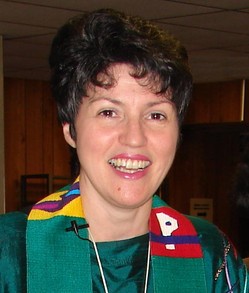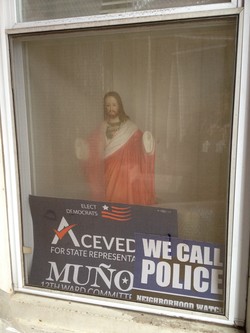The real miracle
A resource for Sunday’s liturgy
based on Luke 7:11–17
Soon afterwards he went to a town called Nain, and his disciples and a large crowd went with him. As he approached the gate of the town, a man who had died was being carried out. He was his mother’s only son, and she was a widow; and with her was a large crowd from the town. When the Lord saw her, he had compassion for her and said to her, “Do not weep.” Then he came forward and touched the bier, and the bearers stood still. And he said, “Young man, I say to you, rise!” The dead man sat up and began to speak, and Jesus gave him to his mother. Fear seized all of them; and they glorified God, saying, “A great prophet has risen among us!” and “God has looked favorably on his people!” This word about him spread throughout Judea and all the surrounding country. Luke 7:11–17
by Magdalena I. García
We love to hear
this kind of miracle story
because it feels good to believe
that if any of our beloved children
were run over by a truck, a train, or a car,
Jesus could bring them back to life.
And yet, we struggle to interpret
this kind of miracle story
because it feels awful to know
that many of God’s beloved children
are run over by hunger, neglect, and violence,
and Jesus cannot bring them back to life.
But perhaps we have it all wrong
and the real miracle that needs to occur
is perfectly within our reach:
is that our vision become clearer
and our will become stronger
so that rather than expect Jesus
to do all the work of restoration
we become committed to the healing
of our cities and our world.
Healer God, release us
from the blindness that prevents us from seeing others,
from the apathy that prevents us from approaching others,
and from the fear that prevents us from embracing others.
Rehabilitating God, give us
discerning eyes to see the needs all around us,
loving hearts to respond with compassion,
and caring hands to make a difference.
Magdalena I. García is a PC(USA) teaching elder and a hospice chaplain for Vitas Healthcare in Chicago. She is a graduate of McCormick Theological Seminary and a recipient of the 2008 PC(USA) Women of Faith Award. Her personal blog is justleros.blogspot.com. Permission is given to use the content in worship with credit to the author and blog. For permission to re-print through other means, please write to magdalenagarcia@comcast.net.

A handless Jesus stands guard in the window of a house in Brighton Park, on the south side of Chicago, perhaps as a reminder that we are God’s hands. / Un Jesús sin manos hace guardia en la ventana de una casa en Brighton Park, en el sur de Chicago, quizás como un recordatorio de que nosotros y nosotras somos las manos de Dios.
El verdadero milagro
Un recurso para la liturgia dominical basado en Lucas 7:11–17
Después Jesús se dirigió a una ciudad llamada Naín. Lo acompañaron muchos de sus discípulos, y una gran multitud. Cuando se acercó a la puerta de la ciudad, vio que llevaban a enterrar al hijo único de una viuda. Mucha gente de la ciudad acompañaba a la madre. Cuando el Señor la vio, se compadeció de ella y le dijo: «No llores.» Luego se acercó al féretro y lo tocó, y los que lo llevaban se detuvieron. Entonces Jesús dijo: «Joven, a ti te digo, ¡levántate!» En ese momento, el que estaba muerto se incorporó y comenzó a hablar, y Jesús se lo entregó a su madre. El miedo se apoderó de todos, y unos alababan a Dios y decían «Un gran profeta se ha levantado entre nosotros», y otros más decían «Dios ha venido a ayudar a su pueblo.» Y la fama de Jesús se difundió por toda Judea y por toda la región vecina. Lucas 7:11–17
por Magdalena I. García
Nos encanta oír
este tipo de historia milagrosa
porque nos sentimos bien al creer
que si cualquiera de nuestros hijos e hijas amados
fueran atropellados por un camión, un tren o un carro
Jesús podría devolverlos a la vida.
Y, sin embargo, nos cuesta interpretar
este tipo de historia milagrosa
porque nos sentimos mal al saber
que muchos hijos e hijas amados de Dios
son atropellados por el hambre, el descuido y la violencia
y Jesús no puede devolverlos a la vida.
Pero quizás estamos equivocados
y el verdadero milagro que necesita ocurrir:
está perfectamente a nuestro alcance:
que nuestra visión se aclare
y nuestra voluntad se fortalezca
para que en vez de esperar que Jesús
haga todo el trabajo de restauración
nosotros y nosotras nos comprometamos con la sanidad
de nuestras ciudades y nuestro mundo.
Dios Sanador, libéranos
de la ceguera que nos impide ver a los demás,
de la apatía que nos impide acercarnos a los demás,
del temor que nos impide abrazar a los demás.
Dios Rehabilitador, danos
miradas perspicaces para ver las necesidades a nuestro alrededor,
corazones amorosos para responder con compasión,
y manos cariñosas para hacer la diferencia.
Magdalena I. García es anciana docente en la IP(EUA) y capellana de hospicio para Vitas Healthcare en Chicago. Se graduó del Seminario Teológico McCormick y recibió el Premio a las Mujeres de Fe de su denominación en el 2008. Su blog personal es justleros.blogspot.com. Se concede permiso para usar el contenido en la adoración dando crédito a la autora y al blog. Para reproducir por otros medios, escriba a: magdalenagarcia@comcast.net.